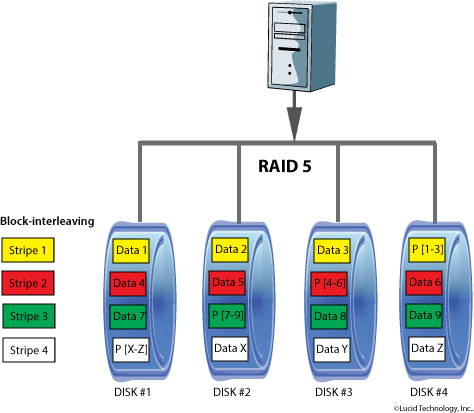RAID 5 / Level 5 RAID / RAID Level 5
The use of dedicated ECC / parity drives in RAID levels 1 through 4 limits each of these
architectures to a single write transaction at a time, and thus they are poor choices for
multitasking or transaction processing systems. RAID 5 attempts to eliminate this
problem. In RAID 5, an entire transfer block is placed on a single drive, but there are no
dedicated data or parity drives. Rather, the ECC blocks are distributed, as shown in
the diagram below, so that each drive in the array contains a combination of
data and parity blocks.

RAID 5 Diagram
Data recovery and seek times are the same as for RAID 4, except that now we
can perform multiple write transactions in parallel. In a saturated I/O situation, we could
have half as many write transactions as the number of drives.
RAID 5 Benefits
The primary advantage of RAID 5 is its ability to perform both reads and writes in
parallel. For ‘n’ drives in the array, virtual transfer rates in a saturated I/O environment
approach ‘n’ times a single drive for all reads and ‘n/2’ times a single drive for writes. In a
combined read/write environment, the virtual transfer rate will be at least ‘n/2’ times a
single drive and will approach ‘n’ times a single drive as the ratio of reads to writes
increases.
